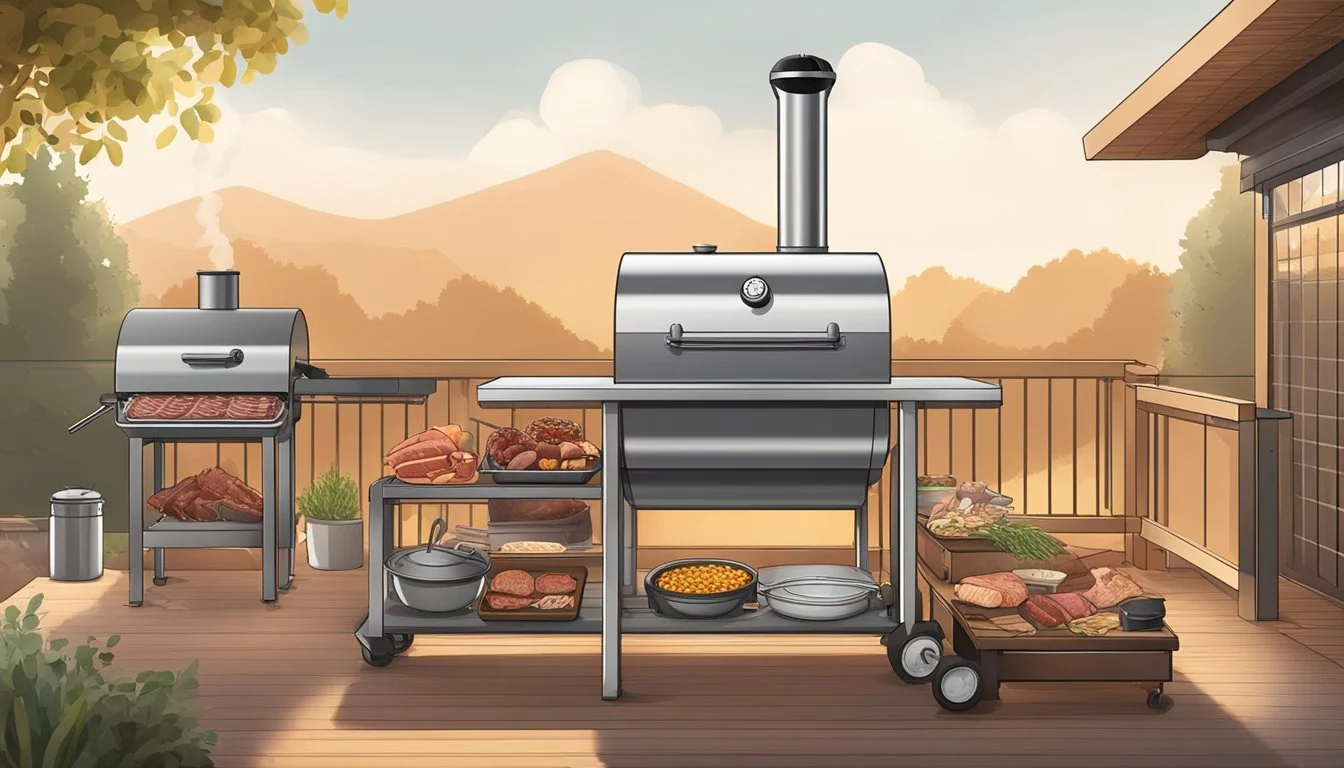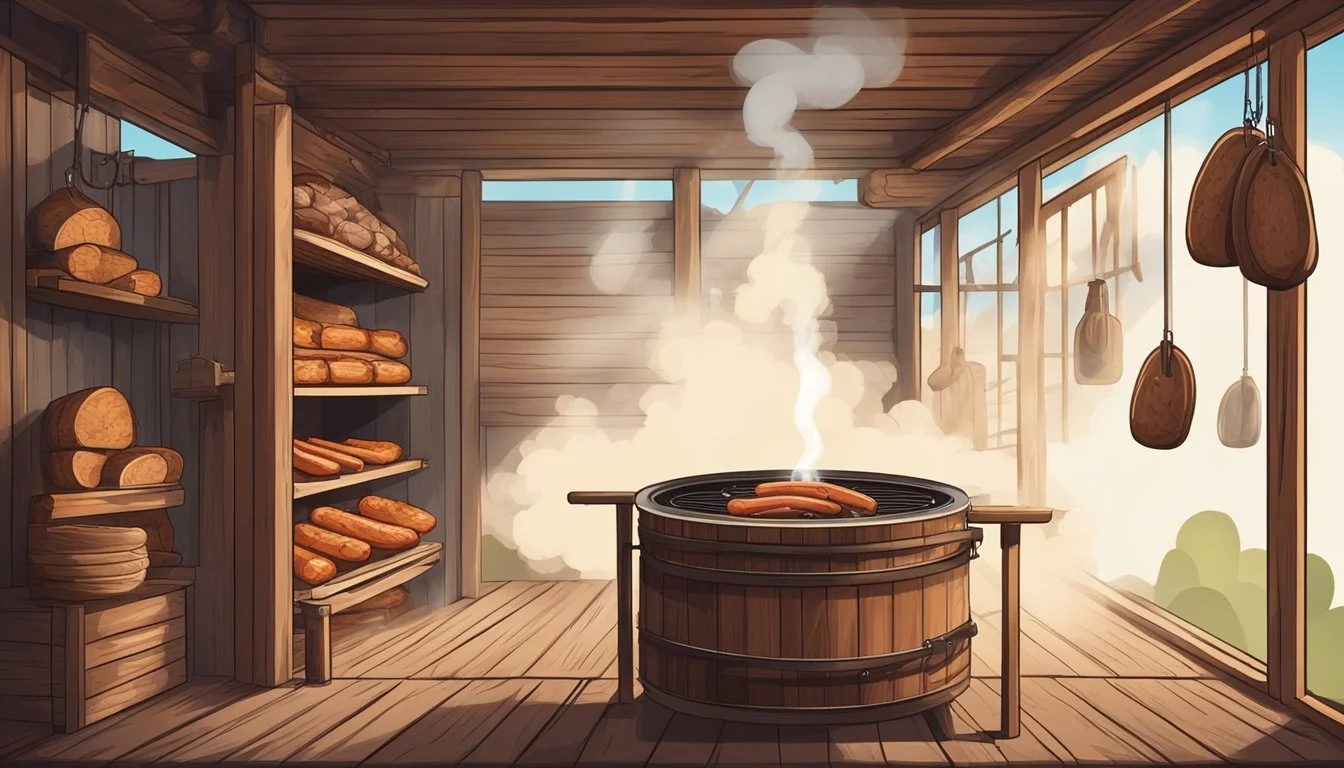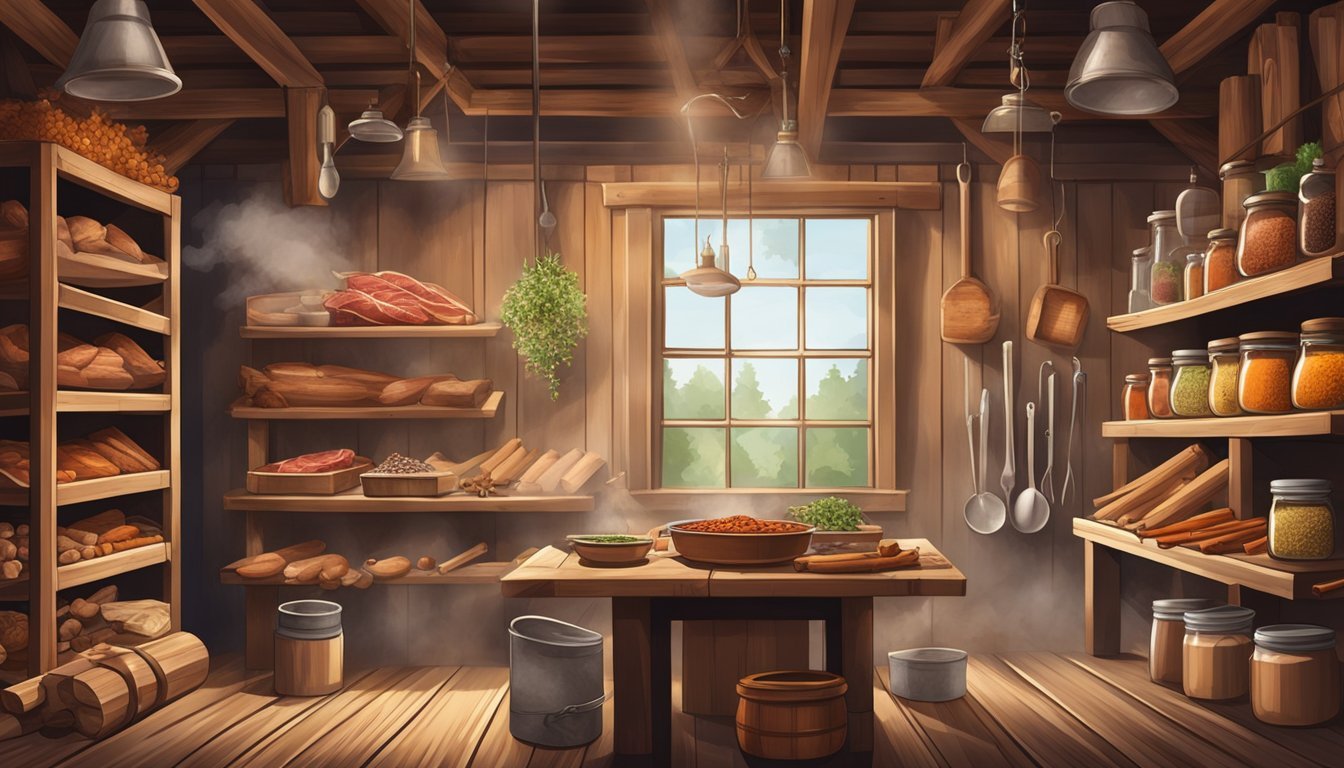How to Cure and Smoke Your Own Meats
The Ultimate DIY Guide
Curing and smoking meats are time-honored techniques that serve both to preserve meat and to enhance its flavor. The art of curing involves treating the meat with salt, sugar, and a combination of spices and curing agents, which not only prolongs the shelf life but also imparts a unique taste and texture. This process typically involves coating the meat with a dry rub or immersing it in a wet brine, allowing the blend of ingredients to penetrate deeply and prepare the meat for the smoking stage.
The smoking process follows curing and serves to further preserve the meat and infuse it with rich, smoky flavors that vary based on the type of wood used. This technique involves exposing the meat to smoke from smoldering wood chips or pellets at low temperatures for an extended period. The combination of curing and smoking can transform a simple piece of meat into a complex, flavorful delicacy with a balance of savory, sweet, and smoky notes that resonate with cultural culinary practices extending back centuries.
Understanding Meat Curing and Smoking
In the age-old practices of curing and smoking meats, understanding the scientific underpinnings and proper techniques is key to success. The use of sodium nitrate and sodium nitrite, along with careful temperature control during smoking, are crucial factors in creating safe, flavorful, and well-preserved meats.
The Science of Curing
The primary goal of curing meats is to preserve them and enhance flavor through dehydration and the prevention of bacterial growth. Curing generally involves the application of salt, and often nitrates and nitrites, directly to the meat. These compounds serve important functions:
Salt draws moisture out of the meat through osmosis, creating an environment less hospitable for bacteria.
Nitrates and nitrites — found in curing salts like Prague Powder #1 (containing sodium nitrite) and Prague Powder #2 (containing both sodium nitrite and sodium nitrate) — act as powerful preservatives. They also contribute to the characteristic pink color and distinct flavor of cured meats (What wine goes well with cured meats?).
Here is a brief overview of common curing ingredients:
Ingredient Function Example Use Salt (NaCl) Dehydration and preservation Basic salt cure Sodium Nitrite (NaNO₂) Preservation, coloring, flavor Used in short cures Sodium Nitrate (NaNO₃) Preservation, converts to nitrite over time Used in long cures
Curing methods vary, with dry curing involving the meat being buried in salt or a mix of salt and curing salts, and wet curing employing a solution—usually a mix of water, salt, sugars, and curing salts to which the meat is submerged.
Basics of Smoking Meats
Smoking meat is both a means to flavor meat and a means to extend its preservation. It involves exposing the meat to smoke from burning or smoldering material, usually wood. The type of wood used will influence the flavor profile of the final product. Here are key components of the smoking process:
Wood: Different woods impart different flavors. Common options include hickory, mesquite, apple, and cherry.
Temperature: Smoking is typically done at low temperatures, usually between 200°F and 225°F, to cook the meat slowly while imparting a smoky flavor.
The smoking process might look like this:
Prepare the meat by curing it as described previously.
Allow the meat to dry until it forms a pellicle, a sticky skin that helps the smoke cling.
Smoke the meat at a controlled temperature for a set period, which varies depending on the type and cut of meat.
By understanding these essential aspects, one can cure and smoke meats effectively at home, creating products that are delicious, safe, and shelf-stable.
Preparation of Meats for Curing
Proper preparation of meats is crucial for successful curing. The process begins with selecting the right quality cuts and then prepping them by trimming. Each type of meat and specific cut has its own texture and qualities that influence the curing process.
Selecting Quality Cuts
When choosing meats for curing, one should prioritize freshness and quality. Beef brisket, (What wine goes well with beef brisket?) pork belly (What wine goes well with pork belly?), pork loin, venison, pork shoulder, and pork butt are all popular choices, each providing a unique texture and flavor profile after curing. Meats should be:
Beef: Look for marbling which indicates tenderness; a good cut for curing is the brisket.
Pork: Popular cuts such as pork belly and pork loin are preferred for their fat content and texture.
Venison: Ensure it is from a reliable source and handled with care due to its leaner nature.
Storage: Meat must be stored at safe temperatures to prevent spoilage before curing begins.
Trimming and Primal Cuts
Before curing, meats should be trimmed of excess fat and any unsightly pieces, as these can affect the overall quality of the final product. The meat should then be cut into the desired primal cuts:
Pork Belly: Often used for bacon (how long does bacon last?), the skin can be left on or removed based on preference.
Pork Shoulder or Pork Butt: Perfect for pulled pork; excess fat should be trimmed but leave enough to maintain moisture.
Beef Brisket: Trim the fat cap to about 1/4 inch to ensure even curing and avoid excessively greasy product.
These initial steps of selecting and prepping the meat are vital for achieving the desired tenderness and texture in the cured product.
The Curing Process
The curing process is an essential method for preserving meat by using curing salt and seasoning, with techniques like dry curing and wet curing to enhance flavor and shelf life.
Dry Curing
Dry curing involves rubbing the meat with a mixture of curing salt and seasoning, which draws moisture out through osmosis. Salt is the primary component of the cure mix, but sugar and other seasonings may be added to impart different flavors. The meat is then left to cure in a controlled environment where humidity and temperature are carefully monitored. Over time, the absence of moisture inhibits bacterial growth, while the salt and seasoning provide a savory character to the meat. A typical ratio used in the mixture could be:
97% regular salt
2% sugar
1% curing salt
During the dry cure, the meat must be stored at the right humidity—around 70-85%—to ensure proper drying without desiccation or spoilage.
Wet Curing and Brining
Wet curing, or brining, involves submerging the meat in a solution of water, salt, and additional flavoring components like sugars and spices. The solution often aims for equilibrium curing, where the meat reaches the same salinity as the brine. This method ensures more uniform distribution of salt and flavors, while also promoting moisture retention through osmosis. The essential components of a brine are:
Water: acts as the solvent
Salt: pivotal for preservation
Sugar: often added for flavor and to balance saltiness
A basic brine ratio might be:
1 gallon of water
3/4 cup of salt
1/2 cup of sugar
After the meat is placed in the brine, it should be kept refrigerated. The duration of wet curing can vary depending on the cut and size of meat, ranging from hours to days. It is important to turn the meat regularly to ensure even curing.
Flavoring and Seasoning
In the world of curing and smoking meats, the use of well-chosen seasonings and sweeteners is invaluable for crafting distinctive flavors and aromas. The right blend of spices and herbs, coupled with the appropriate use of sugars and sweeteners, can transform the taste profile of the meat.
Spices and Herbs
Spices and herbs play an integral role in infusing cured meats with rich flavor and enticing aroma. One must carefully select and combine these elements to complement the natural taste of the meat:
Salt: Essential for both flavor and the curing process.
Black Pepper: Adds a subtle heat that is almost universally appreciated.
Garlic Powder: Provides a warm, savory taste.
Thyme: Contributes a slightly minty, earthy flavor.
Rosemary: Delivers a woody aroma and a sharp, lemon-pine flavor.
Bay Leaves: Impart a subtle depth with floral and herbal notes.
A balanced use of these spices and herbs not only enhances the flavor of the meat but can also contribute to a more appealing finished product.
Sugars and Sweeteners
Sugars and sweeteners are often incorporated into meat curing for both flavor complexity and improved texture. Here's how some commonplace sweeteners are used:
Sugar: Classic table sugar is a staple for a moderate sweet touch.
Brown Sugar: Contains molasses, offering a deeper, richer sweetness.
Honey: Adds a natural, floral sweetness that can impart a delicate flavor.
Molasses: Provides robust, bittersweet flavors and a dark color.
When applied thoughtfully, these sweeteners can counterbalance the saltiness and spices to create a more rounded sensory experience.
Curing Safety Measures
When curing meats at home, one must ensure that the process does not become a breeding ground for bacteria and pathogens. Safety and preservation are the cornerstones of successful meat curing, as they prevent foodborne illnesses, including botulism.
Controlling Bacteria and Pathogens
Meat Selection:
Start with fresh, high-quality meat.
Avoid using meat that shows any signs of spoilage.
Temperature Regulation:
Always cure meat at temperatures below 40°F to inhibit bacterial growth.
Sanitation:
Clean all surfaces, utensils, and hands thoroughly before and after handling meat.
Curing Duration:
Follow specific curing times to ensure pathogens are destroyed without over-curing the meat.
Use of Curing Salts
Purpose of Curing Salts:
Curing salts, such as sodium nitrite or sodium nitrate, are essential for preventing the growth of Clostridium botulinum, the bacteria responsible for botulism.
Types of Curing Salts:
Name Contents Uses Prague Powder #1 Sodium Nitrite (6.25%) Short-term cures, cooked products like bacon Prague Powder #2 Sodium Nitrite (1 oz.) and Sodium Nitrate (0.64 oz.) Long-term cures, such as salami
Use the correct type of curing salt (pink salt) for the specific meat and curing time.
Measure curing salts accurately: misuse can lead to health risks due to high nitrite levels.
By adhering to these safety measures and using curing salts correctly, one can ensure that home-cured meats are both delicious and safe to consume.
Equipment and Storage
When curing and smoking meats at home, one requires specific equipment for the preparation and a controlled environment for storage to ensure safety and quality.
Essential Curing and Smoking Equipment
Curing Salts: A blend of regular salt and sodium nitrite, curing salts inhibit the growth of bacteria.
Containers/Bags: Non-reactive containers or sealable bags that can withstand refrigerator temperatures for meat curing.
Smoking Equipment:
Smoker: A device capable of maintaining consistent low temperatures and smoke for hours or days.
Smoke Generator: An accessory often used for both hot and cold smoking, producing smoke from wood pellets or chips.
Thermometers: To monitor the temperature inside the smoker and the internal temperature of the meat.
Proper Storage and Preservation
Refrigeration:
Fridge: For short-term storage and the curing process with a set temperature that often ranges from 34°F to 38°F.
Curing Chamber: For longer curing periods, outfitted to maintain specific humidity levels and temperature, typically between 50°F and 60°F, and with controlled airflow.
Storage Conditions:
Ensure temperature stability to prevent spoilage.
Maintain proper humidity levels; too high can promote bacteria growth, too low can dry out the meat too quickly.
Adequate airflow to prevent moisture buildup and to ensure even curing and drying.
Smoking Techniques
When smoking meats, one must consider two primary methods: cold smoking and hot smoking. Each technique offers distinct flavors, textures, and suitable uses based on temperature control and the type of wood used.
Cold Smoking
Cold smoking imparts a smokey flavor without cooking the meat. Temperature range for this method is typically between 68°F to 86°F (20°C to 30°C). It's essential for the smoke to flow freely around the meat for even exposure. Meats should be cured properly before cold smoking to inhibit bacterial growth. Common wood chips used in cold smoking include hickory, maple, and apple, each adding a unique flavor profile to the meat.
Hot Smoking
Hot smoking involves cooking the meat at temperatures ranging from 200°F to 300°F (93°C to 149°C). This method can be fueled by charcoal or wood, often using a blend of wood chips to create a deep smoke flavor. The type of wood matters: woods like mesquite bestow a robust taste, while cherry offers a milder touch. Maintaining consistent heat is crucial in hot smoking, ensuring the meat is cooked thoroughly and infused with smoke.
Finishing and Aging
After the initial curing process, finishing and aging are vital to enhance the flavor, texture, and overall quality of the meat. This stage is crucial for achieving the right balance of dryness and maturation.
Drying and Maturing
In the drying and maturing phase, the control of humidity and airflow is essential. The aim is to reduce the weight of the meat through moisture loss, which concentrates flavor and develops texture. Typically, one looks for a weight reduction of around 35% from the original weight to ensure proper drying. Meats should be stored in a space where humidity levels can be kept regulated between 75-85% to prevent the outer layer from drying too quickly and becoming hard. Good airflow assists in even drying, but it's imperative not to rush this process; patience rewards one with optimum quality and texture.
Slicing and Preparation for Consumption
Once the meat has been properly aged and the desired weight and texture have been achieved, it moves to the slicing phase. Slicing should be done with precision to respect the meat's integrity and serve pieces that highlight its quality. Thin, even slices are often preferred to better appreciate the texture and complex flavors developed during curing and aging. Before consumption, the meat should be allowed to rest at room temperature briefly, as this can improve its palatability and bring out subtle nuances in flavor.
Recipes and Techniques
Curing and smoking meats is an art that dates back centuries, serving both to preserve the meat and enhance its flavor. This section delves into some of the most beloved cured meats and provides specific home curing recipes to help one master the techniques.
Popular Cured Meats
Bacon is renowned for its smoky, salty taste and is often made with a dry rub or brine before being cold-smoked. Salami requires a process of fermentation and dry-curing that imparts a complex, tangy flavor. Ham typically undergoes a cure with a brine or dry rub, followed by smoking to instill its distinct taste. Prosciutto is famous for its delicate, mellow flavor achieved through dry-curing with salt and a lengthy aging process. Chorizo combines ground meats with bold spices and is either dry-cured or smoked. Together, these and other meats such as those found in charcuterie boards lend themselves to a myriad of flavors and textures shaped through curing and smoking techniques.
Home Curing Recipes
The Equilibrium Cure technique offers precision. For example:
For each kilogram of meat, use 30g of salt.
Blend the salt with spices or curing salts as needed.
Coat the meat evenly and seal in a vacuum bag.
Cure in a refrigerator, turning occasionally for even distribution.
A sample Dry Rub Cure might be:
Mix sufficient kosher salt with sugar and spices.
Firmly press the mixture over the meat's surface.
Cure in a cool, dry place before smoking.
And for a basic Brine Cure:
Dissolve salt, sugar, and optional curing salt in water to create a brine.
Submerge the meat, ensuring it's completely covered.
Keep it refrigerated during the curing process, turning it periodically.
By adhering to these recipes and paying attention to detail, one can create excellent cured meats in their own home kitchen.
Troubleshooting and Tips
In this section, we provide solutions to common curing challenges and share practical advice for enhancing your smoking technique. Attention to detail and adherence to best practices are pivotal for achieving optimal results in both curing and smoking processes.
Common Curing Problems
Problem: Meat developing mold during the curing process
Solution: Mold on curing meat can sometimes be normal, especially white mold which is often considered a sign of good fermentation. However, if one encounters green, black, or any other colored mold, it should be treated with caution as this could be harmful. It's essential to maintain proper temperature and humidity in the curing environment and ensure that the meat has been properly cleaned before curing.
Problem: Inconsistent flavor or texture
Solution: Consistency issues can often be traced to inaccurate measurements of salt, sugar, or curing agents. Use a precise digital scale to measure your ingredients according to the recipe. It is also important to uniformly distribute the curing mixture over the meat.
Problem: Meat too salty
Solution: If after curing, the meat tastes excessively salty, it can be soaked in water to draw out some of the salt. In future attempts, one may try reducing the curing period or the amount of salt in the cure mix.
Smoking Tips and Tricks
Tip: Achieving the right temperature
Practice: Always use a reliable thermometer to maintain the recommended smoking temperature. Smoking meat at a temperature that's too high can cause it to dry out, whereas too low a temperature may lead to undercooked meat.
Tip: Enhancing flavor with good fungi
Practice: Certain types of white mold are actually beneficial in the smoking process, contributing to the flavor and acting as a natural barrier to the bad molds. However, maintain the smoking environment clean and monitor regularly to prevent the growth of undesirable fungi.
Trick: Managing humidity
Approach: To retain moisture in the meat during smoking and prevent an overly dry outcome, it's crucial to control the humidity in the smoker. Adding a pan of water can help in maintaining a steady humidity level.
Knowing how to respond to these curing questions and smoking challenges can ensure that your home-curing and smoking endeavors yield delicious and safe results.







